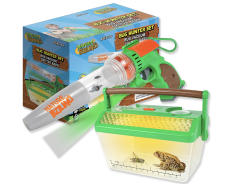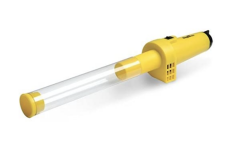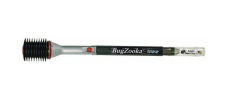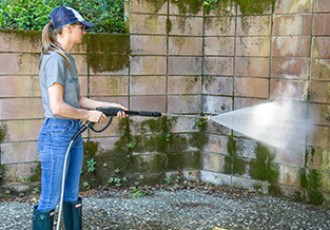BestReviews is reader-supported and may earn an affiliate commission. Details

This is a cruelty-free method for suctioning up almost any bug that creeps around in unwanted areas.
This is a cruelty-free method for suctioning up almost any bug that creeps around in unwanted areas.
Battery-powered vacuum secures insects in a controlled chamber with a built-in magnifying glass for viewing. Features an LED light. Includes vented plastic housing for storing critters after catching.
Some complain the suction is weak, and that the device is overpriced.

This vacuum is a kid-friendly choice for catching creepy crawlies and is easy to use.
This vacuum is a kid-friendly choice for catching creepy crawlies and is easy to use.
Simple to operate due to basic design. Runs on 9V battery power. Easy-on chamber cap to trap bugs. Short shaft on vacuum is ideal for smaller children. Cruelty-free capture through a simple tube. Easy to store and maintain.
The suction power is not as strong as it should be.

This is a user-friendly, suction-free device that is specialized to safely capture and release insects.
This is a user-friendly, suction-free device that is specialized to safely capture and release insects.
Safe handling. Manual controls, so that users don't have to worry about batteries. Simple to catch and release for all ages. Bristles ensure creature gets caught without getting injured. Lightweight and simple to use.
Some reports of the bristles falling off after repeated use.

A fun way to safely trap bugs and spiders and remove them from homes in a cruelty-free manner.
A fun way to safely trap bugs and spiders and remove them from homes in a cruelty-free manner.
Children enjoy using it to catch bugs and set them free outdoors. Lightweight design and single operation make it easy to use. Slim trap chamber keeps bugs safe in transport. No batteries required.
The suction isn't very powerful. Trap door has some design flaws.

We recommend these products based on an intensive research process that's designed to cut through the noise and find the top products in this space. Guided by experts, we spend hours looking into the factors that matter, to bring you these selections.

When it comes to eliminating insects, sometimes using a shoe or rolled-up magazine require you to get too close for comfort. Few are eager to voluntarily place their feet or fingers within inches of an intimidating insect. You could always grab your vacuum, but it might be too heavy to reach the ceiling, or the bug could fly away before you can drag the vacuum to the room. That’s when a bug vacuum comes in handy.
Bug vacuums are appliances that can be used to trap unwanted insects. These long, slender vacuums put plenty of space between you and the insect, with nozzles that are longer than those on traditional vacuums. They’re so lightweight that you can use them to reach bugs in the highest, darkest corners of your house without straining. And many operate on batteries, so they’re not limited by cord length or outlet accessibility.
Different models of bug vacuums come with features that can help or detract from your insect hunting. Which type is best for you? Keep reading to learn more. When you’re ready to buy, check our recommendations for the best bug vacuums on the market.

Consider the size and type of insects you need to nab. A vacuum that’s perfect for stinkbugs may not handle oversized palmetto bugs well. And a machine with strong suction could kill more delicate insects you simply want to relocate. Check to make sure the nozzle and tube are appropriate for the major culprits in your house.
Bug specific: A few vacuums are designed to handle specific infestations, such as bedbugs or dust mites. If you’re trying to get rid of an abundance of a particular pest, check for a tool that specifically targets that species. If you’re just trying to remove a few insects without touching them, look for a less specialized model.
Some people think the only good bug is a dead bug. Others like having pollinators and pest-eating spiders around, just not indoors.
Kill: If you prefer extermination, look for vacuums that finish the job. Different models eliminate insects inside the vacuum using heat, UV exposure, or electrical charges. Make sure the method used is safe for your living space. Also, if you’re not releasing the live insects outside, it’s impractical to empty your bug vacuum after each use. Vacuums that exterminate insects should have a sizable container that lets you go several days, if not longer, without emptying the vacuum.
Some bug vacuums are more educational toy than tool, with a built-in magnifying glass and examination chamber. These bug vacuums will occupy children for hours, but they probably won’t suck up as many bugs as more professional styles. Adults, however, can benefit from this magnifying feature, too. If you’re unsure what kind of insect has infiltrated your house, getting a better view can help you figure out what you’ve captured. Then you can work with your exterminator to make informed choices about addressing or preventing problems.
A bug vacuum can’t do its job without power. Some bug vacuums run on batteries, which limits the length of time you can use it. Others draw their power from an electrical outlet, which restricts where you can use it. A handful create a vacuum suction using airflow technology and can be used anywhere.
Bugs are notorious for scurrying away when they’re discovered. Knowing a bug is hiding in your bedroom is enough to send some people to a hotel for the night. Thankfully, there are bug vacuums that come with LED lights that can illuminate even the darkest spots under your bed or dresser.
The whole point of a bug vacuum is to keep creepy-crawlies far away. Look for one that gives you plenty of space between the nozzle and the handle. Some smaller vacuums are roughly a foot long. The longest provide more than a yard of distance between you and the bug. Longer tubes are also great for sucking spiders out of hard-to-reach ceiling corners.
If you choose a bug vacuum that kills the bugs, you may wish to investigate the methods used for extermination. Some bug vacuums crush the insects; others use high heat, UV exposure, or an electrical charge. Make sure you know that the method used is effective enough, and humane enough, for your comfort.
If you choose a no-kill vacuum, make sure the machine closes securely when the suction stops. Otherwise, the insect you just trapped may crawl right back out. Bugs may be sucked into a sealed chamber or simply kept inside using a trap door. Either way, make sure the seal is secure. Consider the size of the insects you want to trap when making this judgment.
Most of the bug vacuums we reviewed are intended for removing individual insects. A handful are meant for dealing with larger challenges like dust mites or bedbugs. In these cases, a bug vacuum would be used for longer than just a minute or two, so ergonomics is important. A backpack-style vacuum may be more efficient than dragging a canister vacuum around the house. These kinds of tools are usually more expensive than other bug-suckers. If you’re making the investment, be sure the elimination methods, efficacy, and filtration levels meet industry recommendations.
Bug zapper: Flowtron Electronic Insect Killer
You can’t suck up all the bugs outside, so zapping them is the next best plan. Flowtron’s Electronic Insect Killer is suitable for placement away from people, and you can choose your degree of coverage: half an acre, one acre, or one-and-a-half acres.
Bug zapper racket: ELUCTO Electric Bug Zapper
A bug zapper racket is something of an electric fly swatter. It combines the efficacy of a traditional bug zapper with the challenge of the bug vacuum. If you like the satisfaction of swatting at the bugs who are bothering you, this racket from ELUCTO is a good choice.
Insect repellant: Avon Skin-so-Soft
You don’t need to catch them if they stay away from you. Avon’s Skin-so-Soft Bug Guard is also a lotion that moisturizes, hence the name. If you’re interested in an insect repellant with a pleasant scent that is DEET-free, consider trying this time-tested standby.
Insect and spider field guide: Field Guide to Insects and Spiders
If the bugs are bugging you, why not make the most of it and turn it into a science lesson? Kids will love finding out about what they’ve caught with National Wildlife Federation’s handy guide. The colorful photos add to the fun, and you just might find your little ones captivated.
Inexpensive: The least expensive effective bug vacuums cost between $15 and $20. At this price, the vacuum will need to be charged or run on batteries. These are likely no-kill models that trap one small insect at a time for release, and they may have fun features like lights or magnification.
Mid-range: These bug vacuums cost $25 to $30 and have stronger suction. Some are no-kill models, and others eliminate the insects. They may run on batteries or be powered by other means.
Expensive: High-end bug vacuums cost $30 and up, and can cost much more. At this price, most of the vacuums are specialized to deal with more serious insect problems rather than just removing individual bugs. They’re likely plug-in or rechargeable devices that operate like vacuum cleaners and may have species-specific features.
Use a bug vacuum in the garden. Gardeners can use a bug vacuum to remove aphids and other pests from prized plants.
Check for damage. Examine your bug vacuum for any small cracks that could allow a bug to escape. Finding an insect you thought was trapped headed toward your hand is a bad feeling.

Q. Why not use a regular vacuum to suck up bugs?
A. Just ask anyone who’s ever tried to trap a wasp in a bagless vacuum. Most bagless vacuums lack the trap doors that bug vacuums employ, so when the suction ends, the insect can just march right out of the collection bin. This is especially hard to control in handheld vacuums, which are the usual go-to for sucking up bugs. Canister vacuums, on the other hand, are better at keeping insects trapped inside, but they offer no options for releasing the bugs. Bug vacuums are designed with both functions in mind.
Q. How can I release an insect to make sure it doesn’t come back inside?
A. You can’t, really. Release it as far from doors and windows as possible, but if it could get in once, it can do it again. If you notice a dramatic increase in the number of insects coming inside, it might be time to talk to a pest control service about perimeter spraying. Check the conditions inside the house that may be attracting insects, and look for potential cracks and places where they can get in. However, you may see an influx of insects taking refuge inside during rainy or cold weather. It’s annoying, but your new bug vacuum can help you fight the problem until the weather changes.
Q. Can my child use a bug vacuum to catch butterflies?
A. No. The suction and nozzle used to capture smaller insects will damage the wings of a butterfly to the point it cannot fly. Even if you release it, it’s likely to become lunch for a hungry predator. A long-handled net is a much better choice for catching butterflies, dragonflies, and damselflies, assuming you want them to survive.
Get emails you’ll love.
Learn about the products you’re wondering if you should buy and get advice on using your latest purchases.
